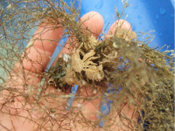Habitat and predation risk in juvenile red king crab
 Crabs that survived laboratory cod predator trials hid inside complex habitats like these hydroids, a structural invertebrate. Photo by Jodi Pirtle.
Crabs that survived laboratory cod predator trials hid inside complex habitats like these hydroids, a structural invertebrate. Photo by Jodi Pirtle.
 Jodi Pirtle dives at an Alaska field site.
Jodi Pirtle dives at an Alaska field site.Ph.D. student Jodi Pirtle, of the University of Alaska Fairbanks Juneau Center, is in her third year of juvenile red king crab experiments. Understanding the role of habitat and predation risk is critical to a successful release strategy (once releases are approved), to increase survival of hatchery reared individuals.
Through laboratory and field experiments, Pirtle aims to understand how nursery habitats support red king crab. Scuba surveys showed that highest abundances of early stage crab are found in structurally complex habitats likely due to predator refuge and food availability. Pirtle and Al Stoner (NOAA Alaska Fisheries Science Center Behavioral Fish Ecology Lab, Newport, Oregon) demonstrated in the lab that young crabs associate with biogenic habitats, such as macroalgae, more than complex physical structure and that crabs prefer to consume structural invertebrates such as hydroids, suggesting that young crabs require habitats that provide both food and structural refuge. The presence of persistent biogenic habitat formed by invertebrates may enhance growth and survival over habitats having seasonal biogenic structure or complex physical structure alone. Using juveniles reared at the Alutiiq Pride Shellfish Hatchery for AKCRRAB, Pirtle conducted experiments at the Newport lab on the effects of predation pressure by cod on crab survival and habitat preference. Crabs had highest survival in complex biogenic and physical habitats in the presence of predators. Interestingly, crabs preferred only complex biogenic habitats in the absence of predators, likely due to increased foraging opportunities. Similarly, predator–associated sheltering has been observed in red king crab juveniles exposed to Pacific halibut (see June 2009 News Flash).
The habitat studies have important implications for growth and the selection of release sites. If crabs are released and take shelter in habitats with low food supplies and high predation pressure, growth and survival may be reduced and affect long–term population strength. This fall, Pirtle will conduct field predation experiments in Alaska with wild–caught crabs to test survival rates of early juvenile crabs in a variety of habitats, identify important predators, and document predator-prey interactions.
The Alaska King Crab Research, Rehabilitation and Biology (AKCRRAB) program is a research and enhancement project sponsored by the Alaska Sea Grant College Program, UAF School of Fisheries and Ocean Sciences, NOAA Fisheries, the Alutiiq Pride Shellfish Hatchery, community groups, and industry members. For more information go to http://seagrant.uaf.edu/research/projects/initiatives/king_crab/general.








